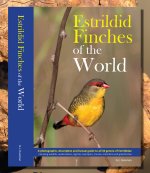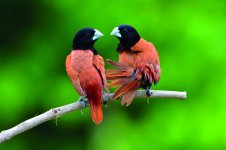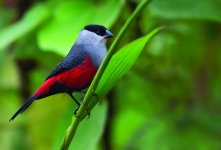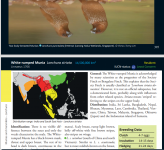-
Welcome to BirdForum, the internet's largest birding community with thousands of members from all over the world. The forums are dedicated to wild birds, birding, binoculars and equipment and all that goes with it.
Please register for an account to take part in the discussions in the forum, post your pictures in the gallery and more.
You are using an out of date browser. It may not display this or other websites correctly.
You should upgrade or use an alternative browser.
You should upgrade or use an alternative browser.
Estrildid Finches of the World (1 Viewer)
- Thread starter Murray Lord
- Start date
More options
Who Replied?MJB
Well-known member
Murray, do you happen to know the authors of the Australian Estrildid finch species accounts?
MJB
Andy Adcock
Worst person on Birdforum

Perhaps heavily inclusive of material from this book?Murray, do you happen to know the authors of the Australian Estrildid finch species accounts?
MJB
Estrildid Finches of the World: Amazon.co.uk: Goodwin, Derek: 9780198585060: Books
Buy Estrildid Finches of the World First Edition by Goodwin, Derek (ISBN: 9780198585060) from Amazon's Book Store. Everyday low prices and free delivery on eligible orders.
www.amazon.co.uk
Andy Adcock
Worst person on Birdforum

I just had a look at the 'flipbook' feature and the only text I'm able to see is in Dutch?
Murray Lord
Well-known member
When you go into the Webshop section, it shows there are separate Dutch and English editions being published.
No, I don't know if there has been anyone from Australia involved in the species accounts; I can see some of the photos are by Australian photographers. HANZAB would be the most up to date source for the Australian species I think.
Did you notice it promises "description and photos of a new estrildid finch species"?
No, I don't know if there has been anyone from Australia involved in the species accounts; I can see some of the photos are by Australian photographers. HANZAB would be the most up to date source for the Australian species I think.
Did you notice it promises "description and photos of a new estrildid finch species"?
Andy Adcock
Worst person on Birdforum

Yes, I wonder if it's the Parrotfinch in the Philippines that James Eaton Discovered but I've yet to see that written up?When you go into the Webshop section, it shows there are separate Dutch and English editions being published.
No, I don't know if there has been anyone from Australia involved in the species accounts; I can see some of the photos are by Australian photographers. HANZAB would be the most up to date source for the Australian species I think.
Did you notice it promises "description and photos of a new estrildid finch species"?
gjhuisman2022
Member

After 9 years of extensive research, I am very pleased to announce that the unique book ‘Estrildid Finches of the World’ will soon be published in English and Dutch. The book consists of 396 A4 pages of descriptive and factual text, 1,052 full-colour photographs and 146 maps, printed on high quality paper and bound with a laminated hard cover. It has been reviewed by scientists as a “fantastic volume”, a “magnificent book …authoritative summary” and “beautifully showcased”.
The book is written for a wide audience, not only bird lovers and watchers, but also ornithologists and other scientists. Estrildid finches are among the most fascinating bird families of the Old World with surprising and special characteristics. The family of Estrildidae comprises 34 genera with 145 species and 239 subspecies, each having its own quirks!
All 145 species and their subspecies are described in detail and the unique distribution maps present the spread of all subspecies in different colours. The descriptions of the species are supported by beautiful photographs of the birds in their natural habitats.
These photos represent the work of close to 300 photographers from 40 countries around the world, whose achievements were vitally important to this huge project. Not only did they afford me permission to use their photos, but they also provided valuable information on the species directly through their first-hand field experience. In fact, some species have never been illustrated photographically before. In addition, I was very fortunate in that several renowned universities, such as Cambridge and Yale, were extremely helpful.
The reader will also be treated to photos of nestlings at different stages of their development, which were taken by bird breeders so as not to unnecessarily disturb the breeding birds in their natural habitats. The book depicts the largest number of mouth markings ever published, with 111 species being illustrated. Original photos show nestling mimicry of estrildid finches and their parasitic whydahs and indigobirds, making this a fascinating resource for evolutionary biologists.
First book with all 145 species, described and showcased in photos taken in the wild.
Close to 300 participating photographers from 40 countries around the world.
Distribution maps of all species and subspecies.
First book with photos of the Alpine Mannikin Lonchura monticola.
Complete listing of parasitic whydahs and indigobirds vs. hosting estrildid finches.
Description and photos of a new estrildid finch species.
“One of the pleasures of paging through this fantastic volume is to see the full force of this avian diversity on show.”
“Less obvious to most field observers, however, but beautifully showcased in this book, is the astonishing diversity in estrildid nestlings.”
“This magnificent book provides an authoritative summary of the state of our knowledge, on which we hope the author, his many colleagues and contributing new estrildid fans inspired by this book, will continue to build.”
Kristof Zyskowski of Yale University, Peabody Museum of Natural History:
“I just wanted to say that I am very impressed with your book project and I am honoured to have my photos included. I think the book will be a fantastic resource with all the photos you managed to gather, especially those of nestling mouth markings. I also love the distribution maps showing subspecies ranges.”
396 pages, printed on high quality paper and bound with a laminated hard cover.
1,052 photographs taken by close to 300 photographers from 40 countries.
146 maps showcasing the distribution of the species and subspecies in detail and colour.
A special pre-order price is available from May 1 to August 1, 2021
The book is written for a wide audience, not only bird lovers and watchers, but also ornithologists and other scientists. Estrildid finches are among the most fascinating bird families of the Old World with surprising and special characteristics. The family of Estrildidae comprises 34 genera with 145 species and 239 subspecies, each having its own quirks!
All 145 species and their subspecies are described in detail and the unique distribution maps present the spread of all subspecies in different colours. The descriptions of the species are supported by beautiful photographs of the birds in their natural habitats.
These photos represent the work of close to 300 photographers from 40 countries around the world, whose achievements were vitally important to this huge project. Not only did they afford me permission to use their photos, but they also provided valuable information on the species directly through their first-hand field experience. In fact, some species have never been illustrated photographically before. In addition, I was very fortunate in that several renowned universities, such as Cambridge and Yale, were extremely helpful.
The reader will also be treated to photos of nestlings at different stages of their development, which were taken by bird breeders so as not to unnecessarily disturb the breeding birds in their natural habitats. The book depicts the largest number of mouth markings ever published, with 111 species being illustrated. Original photos show nestling mimicry of estrildid finches and their parasitic whydahs and indigobirds, making this a fascinating resource for evolutionary biologists.
Highlights
The largest collection of estrildid finch mouth markings worldwide containing 111 unique photos, many never published before.First book with all 145 species, described and showcased in photos taken in the wild.
Close to 300 participating photographers from 40 countries around the world.
Distribution maps of all species and subspecies.
First book with photos of the Alpine Mannikin Lonchura monticola.
Complete listing of parasitic whydahs and indigobirds vs. hosting estrildid finches.
Description and photos of a new estrildid finch species.
Reviews
Nigel Collar of BirdLife International, Gabriel Jamie and Claire Spottiswoode of Cambridge University and University of Cape Town, wrote the comprehensive foreword to the book, as quoted:“One of the pleasures of paging through this fantastic volume is to see the full force of this avian diversity on show.”
“Less obvious to most field observers, however, but beautifully showcased in this book, is the astonishing diversity in estrildid nestlings.”
“This magnificent book provides an authoritative summary of the state of our knowledge, on which we hope the author, his many colleagues and contributing new estrildid fans inspired by this book, will continue to build.”
Kristof Zyskowski of Yale University, Peabody Museum of Natural History:
“I just wanted to say that I am very impressed with your book project and I am honoured to have my photos included. I think the book will be a fantastic resource with all the photos you managed to gather, especially those of nestling mouth markings. I also love the distribution maps showing subspecies ranges.”
Technical details
A4 format.396 pages, printed on high quality paper and bound with a laminated hard cover.
1,052 photographs taken by close to 300 photographers from 40 countries.
146 maps showcasing the distribution of the species and subspecies in detail and colour.
Orders
The book can be ordered via our website www.finches.nlA special pre-order price is available from May 1 to August 1, 2021
Attachments
gjhuisman2022
Member

The new book has nothing to do with the book from Derek Goodwin.Perhaps heavily inclusive of material from this book?
Estrildid Finches of the World: Amazon.co.uk: Goodwin, Derek: 9780198585060: Books
Buy Estrildid Finches of the World First Edition by Goodwin, Derek (ISBN: 9780198585060) from Amazon's Book Store. Everyday low prices and free delivery on eligible orders.www.amazon.co.uk

These are definitely features to attract evolutionary biologists!............................
The largest collection of estrildid finch mouth markings worldwide containing 111 unique photos, many never published before.
Distribution maps of all species and subspecies.
Complete listing of parasitic whydahs and indigobirds vs. hosting estrildid finches.
.............................................
Do these maps also include introductions? A feature completely missing in HBW and its offshoots, as far as I remember.
gjhuisman2022
Member

Andy Adcock
Worst person on Birdforum

I think the cagebird market is definitely a target when you see the information re 'clutch size, incubation, fledging' which isn't something you see in many guides.Obviously aimed also at cagebird keepers. But estrildids are cute and beautiful, it is easy to overlook that.
gjhuisman2022
Member

My book is written for bird watchers, bird keepers, ornithologists and all othe people who like this special avian family. But it is definately not a guide how to keep or breed birds.
Users who are viewing this thread
Total: 2 (members: 0, guests: 2)








